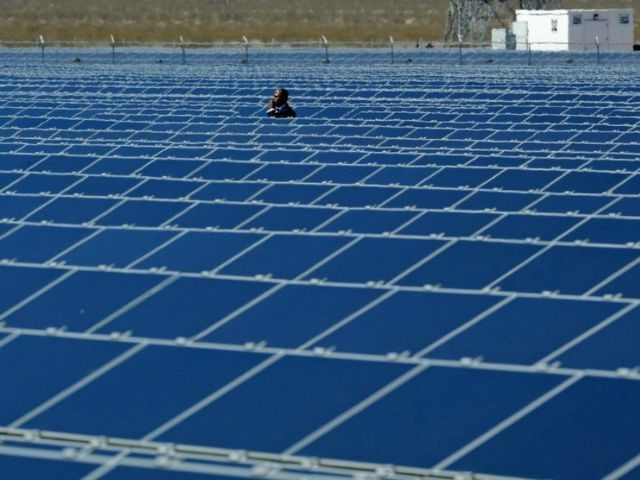Researchers find that some buyers pay for environmentally friendly products because those products act as “status symbols.”
A report in the Atlantic states: “Environmentally-friendly behaviors typically go unseen; there’s no public glory in shortened showers or diligent recycling. But when people can use their behavior to broadcast their own goodness, their incentives shift. The people who buy Priuses and solar panels still probably care about the environment—it’s just that researchers have found that a portion of their motivation might come from a place of self-promotion, much like community service does good and fits on a résumé.”
With “green” having become a status symbol, the affluent can afford it. Yet, their desire to “broadcast their own goodness” actually results in higher costs to those who can least afford it.
Solar power is a great example. On the website for SunRun, a solar panel leasing company, through the story of customer “Pat,” they even encourage the “green status symbol” as a sales feature. While Pat may be happy with her solar panels and “hopes that all her neighbors will go solar, too,” her “green status symbol” costs all the utility’s customers who mostly can’t afford to “go solar.”
As I’ve written on many times, the idea of solar leasing works because of tax incentives and a system called “net metering.” First, those tax incentives are paid for by all taxpayers. Anytime the government gives something away, everyone pays for it. Net metering is a little harder to understand. In short, the utility is required by state laws to purchase the extra electricity generated by rooftop solar panels at the full retail rate—even though they could purchase it at a fraction of the cost from the power plant. As more and more people sign up for these programs, it increases the overall cost of electricity. Remember, however, those with solar panels could have a zero dollar utility bill but they are still using electricity from the utility company when the sun doesn’t shine and generate additional customer service costs such as transmission lines. Ultimately, the cost of electricity goes up on the bills of non-solar customers. Due to this “cost shifting,” many states are changing the net metering policies so solar customers cover the unpaid grid costs. However, as has happened recently in Nevada, the revised programs change the economics and make it unprofitable for companies to operate in the state.
This is clear to see in overall rising electric costs—about 3 percent per year according to the Institute for Energy Research—despite the main fuel costs (coal and natural gas) being at all-time lows.
Earlier this month, Investors Business Daily (IBD) addressed another interesting angle: “Green energy can’t compete with $30 oil.” The only way for “green” energy to survive, it says, is: “by the government forcing people to buy them and jacking up electricity and heating prices to families and businesses.”
A new study from the University of Chicago, referenced by IBD, concludes that for an electric vehicle to be cheaper to operate than the modern internal combustion engine, “the price of oil would need to exceed $350 a barrel.” The IBD states: “without massive additional taxpayer subsidies to companies such as Tesla, the price of oil would have to not just double or triple, but rocket more than 10-fold before battery-operated cars make financial sense.”
Yet, sales for the Tesla Model S, the International Business Times (IBT), reports: “actually rose 16 percent last year, in part because they serve as status symbols or appeal to the environmental concerns of well-to-do drivers.”
Recycling, a “green” fixture, has taken a toll in the low oil-priced environment. Calling recycling a “$100-billion-a-year business,” National Public Radio reporter Stacy Venek Smith, points out: “Plastic is made from oil, so when oil gets cheap, it gets really cheap to make fresh plastic. When the price of oil gets really low, using recycled plastic can actually be more expensive because it has to be sorted and cleaned.” In Salt Lake City, KUTV reported: “Many businesses are finding it cheaper to manufacture new plastic than to use recycled materials.” In Montana, according to the Philipsburg Mail, plastics are no longer being picked up for recycling “because the price per pound was so low, it didn’t cover the cost of gas and mileage to make the trip.”
Addressing the recycling problem, The Guardian states: “Recycling only works when there’s someone on the other side of the equation, someone who wants to buy the recycled material.”
Fortunately for the recycling industry, but bad for consumers who pay higher prices for plastic products, the Philipsburg Mail concludes: “A lot of Fortune 500 Companies still want to purchase recyclables to meet sustainability goals.”
Despite claims of “green prosperity” that implies such policies can “fight poverty and raise living standards,” the opposite is true. Everyone pays more—even those who can least afford it—so the elites, seeking green status symbols, can feel good and appear to be community leaders.
The author of Energy Freedom, Marita Noon serves as the executive director for Energy Makes America Great Inc., and the companion educational organization, the Citizens’ Alliance for Responsible Energy (CARE). She hosts a weekly radio program: America’s Voice for Energy—which expands on the content of her weekly column. Follow her @EnergyRabbit.

COMMENTS
Please let us know if you're having issues with commenting.